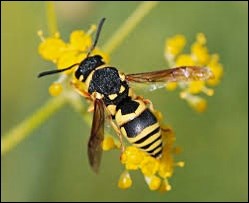The buzz in the garden right now is wasps! This tells me we have recently reached late summer and the savvy insects that have to over winter outside are already beginning to prepare. During late summer wasps prefer to dine on protein and will also become more aggressive.
Wasps serve a role in the food chain as they rid the garden of many pests. Sometimes it is hard for us to remember their worth, but they are important. They belong to a large diverse group of insects that prey on other insects. Their major food source is other bugs – flies, caterpillars, grasshoppers and a host of other backyard pests. They belong to the Vespidae family or the colonial wasp. There are only three types of colonial wasps in North America: yellowjackets, paperwasps and the bald-faced hornet.
There is, of course, no magic solution to avoiding wasps at this time of year – except of course to stay inside, which is really not a solution at all. However, try to avoid wearing sweet scents when working outside as that will definitely attract wasps. If you are noticing a large number of wasps then it is likely there is a nest nearby. Usually, a huge abundance of wasps is due to some human factor, like the preference to enjoy summer and eat outside. Barbecues, picnics and outdoor gatherings easily provide a great food source for wasps – one they do not have to search for! Crumbs, spilled juice, bones and a variety of other food-like garbage provide easy pickings for wasps.
If there is an abundance of wasps then it is time for some detective work. It is relatively easy to watch where the wasps are flying to determine the location of the nest. Wasps will generally fly only within about 300 metres of the area they frequent. Once the nest is found, the choice is yours whether to eradicate it or not. If you choose to rid the garden of these critters then there are a number of sprays on the market that work well. Please follow all directions carefully. One solution in areas that humans frequent is to use a bait or a trap. There are a variety of wasp traps on the market, some which are really quite beautiful. If you choose to make your own it is relatively easy. Use a plastic pop bottle and pour a bit of fruit juice, leftover food or ripe fruit as a bait in the bottom of the bottle.
If you do happen to get stung, wash the wound with soap and water. Treat the wound with ice, meat tenderizer or a freshly cut onion to help destroy the venom. Anti-histamines are a good idea as they reduce symptoms of pain and swelling. Rest and do not drink alcohol. Ensure that you seek medical attention if the sting is close to the mouth or throat or if you have an allergy to stings.
— Hanbidge is a horticulturist with the Saskatoon School of Horticulture and can be reached at 306-931-GROW(4769); by email at growyourfuture@gmail.com or check out our website at www.saskhort.com.



